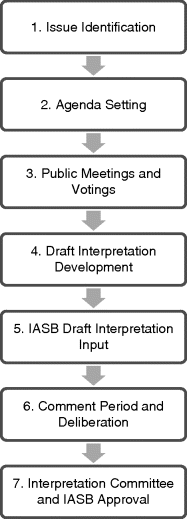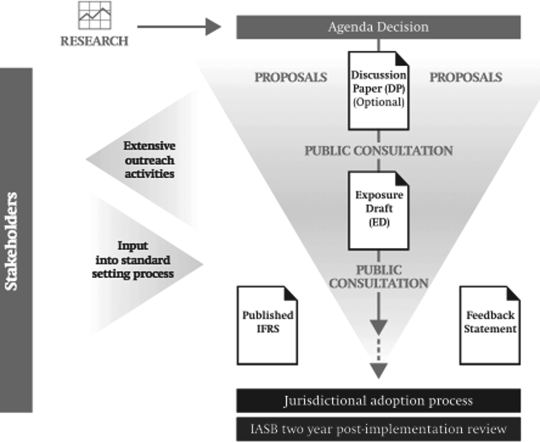IASB Authorities
The IASB issues pronouncements labeled International Financial Reporting Standards (IFRS) and interpretations labeled IFRICs. IFRICs interpret the IASB's own statements. The IASB also recognizes predecessor authorities from the IASC titled International Accounting Standards (IAS) and Standards Interpretations Committee interpretations (SIC). As of July 2012, the IASB follows 28 of the 41 previously issued IASs and has issued 13 new IFRSs. Most IFRSs contain:
1. An introduction
2. A table of contents
3. An objective
4. A scope
5. Definitions
6. The actual standard
7. A list of the IASB members actually voting
8. The basis for a qualifying or dissenting vote of an IASB member
9. Appendices containing background information, a glossary of terms, examples of applying the standard, and other ancillary information
IFRSs are used as a basis of financial reporting for many companies, stock exchanges, and regulatory authorities that allow presentation of financial statements using IFRS. IFRSs are also used by supranational bodies to produce results that meet the needs of capital markets, by many countries having national accounting requirements, and as international benchmarks by countries that develop their own accounting requirements.
The Standards Interpretations Committee (SIC) was established in 1997 to timely answer questions by financial statement preparers and users about issues not clearly covered by an existing set of authoritative pronouncements. As of July 2012, 8 of its 33 interpretations are still followed.
The Interpretations Committee replaced the International Financial Reporting Interpretations Committee (IFRIC) and the SIC. It produces interpretations labeled IFRICs, and 16 of the 20 previously issued interpretations are in use. The Interpretations Committee can address industry-specific issues rather than those encompassing accounting and financial reporting as a whole. For example, IFRIC No. 20, “Stripping Costs in the Production Phase of a Surface Mine,” applies primarily to the mining industry. To prevent divergence, clarification may be necessary, such as in IFRIC No. 10, “Interim Financial Reporting and Impairment,” which addresses whether an entity should reverse impairment losses recognized on goodwill in an interim period.
When lack of consensus exists on an issue under consideration by the Interpretations Committee, and the Interpretations Committee decides that the problem merits further action, it will forward the file to the IASB for further deliberation. Conversely, if the Interpretations Committee can reach a consensus on an issue, the IASB can usually infer that no Board action is necessary. Approved Interpretations Committee interpretations have the same authority as IASB Standards. The interpretations (IFRICs and SICs), along with the original pronouncements, are collectively known as IFRS(s).
IASB Due Process
Given the importance of IASB Standards, an extensive due process was adopted in order to address transparency, accessibility, extensive consultation, responsiveness, and accountability. Additionally, a Due Process Oversight Committee (DPOC) was created to:
- Review and update the due process handbooks;
- Oversee (1) the IASB with respect to due process compliance and (2) the trustee's function with respect to operating in accordance with the Constitution; and
- Approve the working group composition.
The IASB's six-stage due process, as depicted in Exhibit 3-4 and set out in the Constitution, is as follows:
1. Input from working groups and item evaluation. Before a potential agenda item is set, the IASB receives input from working groups within the IASB, the Interpretations Committee, and the Advisory Committee. The IASB considers the potential agenda item's relevance, existing accounting guidance, the possibility of increased convergence, the potential quality of any proposed standard, and the resources needed to examine the potential agenda item.
2. Plan a research project. The IASB plans the research project to determine whether to work with other accounting standard setters, such as forming working groups comprised of staff and/or members from the various standard-setting bodies. The IASB's working groups are chaired by the director of technical activities or director of research.
3. Issue a discussion paper (optional), allow public comment, and analyze comment letters. Developing and publishing a discussion paper is not a mandatory stage, but the action is usually taken to obtain early feedback from constituents. If the discussion paper is omitted, the IASB will explain why. Typically, a discussion paper includes an examination of the topic, the alternative accounting treatments, the standard setters’ views, and an invitation for comment. If another standard setter initiated the discussion paper, the IASB requires a simple majority vote before publication. If the IASB or one of its working groups initiated the research, the discussion paper is published because all IASB sessions are public. Analysis is performed on the comment letters received during the usual 120-day comment period, and the results are posted to the IASB website.
4. Publish an exposure draft (ED). Developing and publishing the ED is mandatory and is based on IASB staff research, discussion paper comments, Advisory Council input, working groups, and other standard-setter input. Before the ED is issued for comment, a ballot takes place requiring approval by 9 of the 14 IASB members (the number of members needed for approval will increase when IASB membership increases to 16 members in mid-2012). ED periods are usually 120 days or longer for major projects; if a matter is urgent, the ED period is 30 days. Once comments are received, they are summarized and posted to the IASB website.
5. Draft an IFRS or a second ED. The IASB then decides whether to draft an IFRS or publish a second ED. If IFRS is drafted, the IFRIC reviews the draft before it goes to the IASB for a vote. A version of the IFRS draft is also posted for paid subscribers. An IFRS is issued only after any outstanding issues are resolved and the IASB members have voted in favor of the standard.
6. Provide implementation guidance. The IASB and its staff periodically hold meetings with constituents with respect to implementation guidance and any unforeseen standard shortcomings. The IFRS Foundation promotes educational seminars and events to ensure proper application of IFRS.
Interpretations Committee Due Process
IFRICs are issued to clarify IFRSs or prevent diverging viewpoints. A seven-stage due process is followed for issuing interpretations. During the process, the Interpretations Committee ensures that its focus remains principle-based, it considers potential international convergence, and it ensures that its guidance does not change or conflict with existing IFRSs or the Framework. The Interpretations Committee seven-stage due process, as depicted in Exhibit 3-5 and set out in the Constitution, is as follows:
1. Identify the issue. A detailed description and evaluation of an issue may be put forward by individuals or an organization, by email or regular mail. The IASB staff assesses the issue and determines if it can be put on the agenda or requires additional input.
2. Set the agenda. The Interpretations Committee holds a public debate and decides whether to add the issue to the agenda. The issue is examined for relevance, divergence, improved financial reporting, scope, ability to reach a consensus, and if related to a current or planned IASB project. A comment period of at least 30 days is set, at which time a simple majority of Interpretations Committee members can choose to add an issue to the agenda.
3. Meet and vote. Public meetings are held in which the Interpretations Committee debates items proposed and actual agenda items. A quorum consists of 10 voting members (in person or by teleconference).
4. Develop a draft interpretation. IASB staff members present papers with information describing the issue along with background information such as a description of the issue, the specific issue to be considered by the Interpretations Committee, any relevant Conceptual Framework concepts, alternatives, relevant IASB pronouncements, and a recommendation. The Interpretations Committee then develops and votes publicly on the draft interpretation, which includes a summary of the issue, the consensus reached (no more than four members voting against a proposal), references (IFRSs and/or Conceptual Framework), and an effective date.
5. Allow for IASB input. The IASB plays a role in the release of a draft interpretation. IASB members comment on all Interpretations Committee agenda papers and are informed when the Interpretations Committee reaches a consensus. A draft interpretation is released for public comment.
6. Allow a comment period. Draft Interpretations are publicly available for at least 60 days. Comment letters are examined and summarized. At this time, the Interpretations Committee determines whether to finalize the interpretation or reexpose it.
7. Approve the Interpretation. An interpretation is approved by the Interpretations Committee and the IASB. After there is a consensus, the interpretation is put forth for IASB ratification in a public meeting.
Having completed a due process procedure, the IASB's or Interpretations Committee's final pronouncement is placed at an equal level in the IFRS hierarchy. All throughout the due process, IFRSs and IFRICs are summarized in nontechnical language in the IFRS Foundation's Insight journal. Final technical summaries are posted on the IASB website and the full standard is placed in eIFRS, discussed later in this chapter.


